History of Virginia Tech in the D.C. Area
Virginia Tech is firmly planted in the greater Washington, D.C., area and continues to advance the university missions of instruction, research, and outreach. With humble beginnings in a Reston farmhouse, which served as a graduate center in 1969, the greater D.C. area locations today include the Washington Alexandria Architecture Center (WAAC) in Old Town Alexandria, Academic Building One in in Alexandria's Potomac Yard district, and the Virginia Tech Research Center in Arlington. Some 1,077 graduate students are enrolled in more than 45 graduate degree programs taught by 120 full-time faculty members. More than 85 active researchers are responsible for research expenditures in excess of $15 million, and growing.
The following timeline provides a look at how Virginia Tech has grown and continually affirms a strong presence in the greater D.C. area by adding buildings, creating new graduate programs and research centers, and forming notable collaborations and partnerships that further foster education and research.
The late Paul Mellon and his wife donate a 420-acre farm in Middleburg to Virginia Tech. The Middleburg Agricultural Research and Extension (MARE) Center is devoted primarily to beef cattle research until 1992.
The Virginia Cooperative Extension opens an office in Arlington County.
The College of Architecture and Urban Studies (CAUS) offers an Urban Affairs and Planning graduate program.
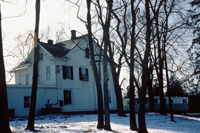
Virginia Tech opens the door to its first Northern Virginia Graduate Center, located in a Reston farmhouse on Sunset Hill Road. Homer Kempfer is appointed the first director of the center. There are two resident faculty members, a part-time staff, and 65 students.
The College of Education offers graduate degrees in Adult Learning.
An economics program is initiated, doubling the number of resident faculty.
The Occoquan Watershed Monitoring Laboratory (OWML) opens in Manassas.

Having outgrown space in a Reston farmhouse, Virginia Tech moves its graduate center to the first floor of the Dulles International Airport Gateway 1 building.
- The College of Business offers an MBA degree.
An engineering program begins in the region.
- The College of Architecture and Urban Studies (CAUS) offers a Ph.D. in Public Administration and Policy.
- The College of Engineering offers an M.S. and Ph.D. in Computer Science.
The Virginia Cooperative Extension in Arlington County launches the first Farmer's Market in the area.
- The College of Architecture and Urban Studies (CAUS) pilots the Washington Alexandria Architecture Center program at the former school house located at 1001 Prince Street. The building was loaned to Tech by the City of Alexandria.
- In the College of Education, the Adult Learning program hires full-time faculty in the region.
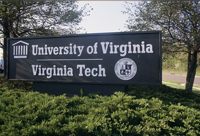
Virginia Tech and the University of Virginia move their shared graduate center in the region from the first floor of the Dulles International Airport Gateway 1 building to Telestar Court in Falls Church.
- Following the successful pilot in 1980, the College of Architecture and Urban Studies (CAUS) formally launches the Washington Alexandria Architecture Center (WAAC) in leased facilities at 101 Columbus Street.
The College of Engineering offers its first graduate programs.
The Marion duPont Scott Equine Medical Center, one of three campuses of the Virginia-Maryland Regional College of Veterinary Medicine, opens in Leesburg as a teaching hospital.
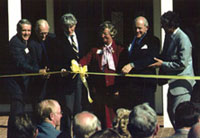
(left to right) Former Virginia Tech President William
Lavery, former Westmoreland Davis Memorial Foundation Trustee
Leonard T. Scully, Senator John Warner, Mrs. Jean Ellen
duPont Shehan, University of Maryland President Dr. John
Toll and Dr. G. Frederick Fregin cut the ribbon at the Marion
duPont Scott Equine Medical Center's dedication ceremony
in October 1984.

Marion duPont Scott Equine Medical Center at 17690 Old Waterford Road at Morven Park
- The Virginia Tech Foundation purchases the building at 101 Columbus Street, housing the Washington Alexandria Architecture Center (WAAC).
- The Adult Learning program is relocated from Blacksburg to the National Capital Region.
- The Washington Alexandria Architecture Center (WAAC) establishes the Architecture Consortium which allows participating universities from around the world to send students and faculty members to Alexandria for a semester or academic year.
- The Virginia Tech Foundation purchases two buildings on Patrick Street in Old Town Alexandria. The Rectory houses the American Institute of Architects (AIA) offices and The Gallery serves as a limited capacity dormitory for students in the region.
- Computer Science in the College of Engineering offers an M.S. in Information Systems.
- George Truman “G.T.” Ward, partner and principal, Ward/Hall Associates, AIA; member, Virginia Tech Board of Visitors; and 1951 Virginia Tech alumnus, spoke at commencement.
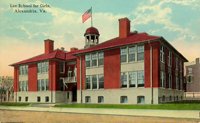
The Virginia Tech Foundation sells the building at 101 Columbus Street and purchases a historic building in Old Town Alexandria, the old schoolhouse at 1001 Prince Street. It becomes the permanent home for the College of Architecture and Urban Studies' Washington Alexandria Architecture Center (WAAC). Built in 1910 as the Lee School for Girls, the City of Alexandria used the building as a public school until 1980.
The Middleburg Agricultural Research and Extension (MARE) Center rededicates itself to equine research. The center's former focus, on beef cattle research, dates back to 1949 when Virginia Tech acquired the 420-acre farm from the late Paul Mellon and his wife.
The College of Architecture and Urban Studies' Center for Public Administration and Policy (CPAP) offers an MPA program at Telestar Court.
College of Natural Resources offers a graduate program at the Telestar Court facility.
- Groundbreaking is held for the Virginia Tech/University of Virginia Northern Virginia Center (NVC) in Falls Church, 7054 Haycock Road.
- Science and Technology Studies is added to Virginia Tech graduate programs in the region.

In 1997, Virginia Tech and the University of Virginia dedicates
the Northern Virginia Center (NVC), a 105,000-square-foot,
state-of-the-art
graduate center located adjacent to the West Falls Church Metro
station. At the ribbon cutting ceremony (left to right) were: Paul
Torgersen,
President, Virginia Tech; John Casteen, President, University of
Virginia; Dale Dover, Mayor of Falls Church; Katherine Hanley, Chairman,
Fairfax County Board of Supervisors; U.S.
Senator Chuck Robb; U.S. Representative Tom Davis, and Virginia
Delegate Bob Hull.

Northern Virgina Center, 7054 Haycock Road, Falls Church.
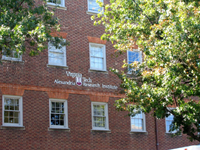
The Alexandria Research Institute (ARI) launches at 405 South Washington Street, Alexandria, to provide a platform for engineering and computer science researchers to interact with their counterparts in academia, government, and industry in the metropolitan DC area. ARI also serves as a gateway to the R&D base at the main campus in Blacksburg. (Renamed Advanced Research Institute in 2005.)
- The College of Architecture and Urban Studies (CAUS) offers a master's degree in Landscape Architecture.
- Virginia Tech offers the Master of Information Technology (MIT) program, a joint degree between the College of Engineering and the Pamplin College of Business.
The College of Engineering offers full-time M.S. and Ph.D. programs.
- Virginia Tech establishes Northern Virginia Operations and names James Bohland executive director.
- The Center for Food, Nutrition, and Policy (CFNP) serves as a Virginia Tech research center (until 2005).
- The International Institute for Information Technology (IIIT) is formed, led by Leonard Ferrari, vice provost for special initiatives, with offices in the Alexandria Research Institute (ARI). IIIT later combines with Northern Virginia Operations in 2003.
- The College of Natural Resources names David Trauger full-time director of the Natural Resources masters program.
- The Center for Food, Nutrition, and Policy (CFNP) serves as a Virginia Tech research center (until 2005).
- The International Institute for Information Technology (IIIT) is formed, led by Leonard Ferrari, vice provost for special initiatives, with offices in the Alexandria Research Institute (ARI). IIIT later combines with Northern Virginia Operations in 2003.

The Metropolitan Institute (MI) at Virginia Tech and other graduate programs move into a newly renovated building at 1021 Prince Street in Old Town Alexandria. The building was purchased by the Virginia Tech Foundation in 2001.
- The Pamplin College of Business inaugurates an Executive MBA Program
- The Center for Geospatial Information Technology (CGIT) launches, supported by IIIT and Tech’s ASPIRES program. CGIT has bases in Old Town Alexandria and Blacksburg and is led by Randy Dymond.
- Virginia Tech announces that National Capital Region will replace Northern Virginia Operations as the new identifier for all Virginia Tech facilities in Northern Virginia, including graduate programs and research centers in Alexandria, Arlington, Falls Church, Leesburg, Manassas, and Middleburg.
- The College of Engineering offers a Ph.D. in Industrial and Systems Engineering.
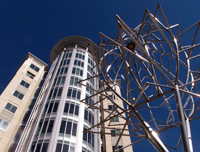
The Alexandria Research Institute (ARI) moves to the Ballston area of Arlington and is renamed the Advanced Research Institute.

Virginia Tech holds its 25th National Capital Region commencement ceremony. Pictured right is Virginia Tech President Charles Steger addresses graduates at the 25th National Capital Region commencement ceremony.

The first cohort in the Pamplin College of Business Executive MBA Program graduates in 2005. The graduates are pictured here with former Vice President Walter Mondale who addressed participants and guests during a ceremony at Mount Vernon.
The Virginia Bioinformatics Institute (VBI) opens an office in Old Town Alexandria at 1101 King Street.

President Charles Steger answers questions during a press event to launch the Energy Efficiency Partnership of Greater Washington in 2007.
- Virginia Tech, Hannon Armstrong, and Pepco Energy Services launch the Energy Efficiency Partnership of Greater Washington.
- The Global Issues Initiative (GII) in the newly formed Institute for Society, Culture and Environment (ISCE) names David Orden as director.

Congressman Jim Moran, of Virginia's Eighth Congressional District, was a guest speaker when Virginia Tech President Charles Steger announced in 2008 that Virginia Tech is building a major research center in the Ballston area of Arlington.
- Virginia Tech and Georgetown University offer a joint graduate level degree, Master of Science in Biomedical Technology Development and Management.
- Virginia Tech announces that it will build a major research center in the Ballston area of Arlington, with planned occupancy by late 2010. The seven- story, 144,000-square-foot building will be owned by the Virginia Tech Foundation.
- Virginia Tech offers a geospatial graduate degree program in College of Engineering designed for students in the National Capital Region.
- The Language and Culture Institute opens a second program in National Capital Region, and lanuches its first English Language Program (ELP) classes with six international Fulbright scholars. Andrea Todd is named associate director of the program.

Construction is underway on Virginia Tech’s major research center in the Ballston area of Arlington. The seven-story 144,000 square-foot building will be owned by the Virginia Tech Foundation.

Left to right, Seong K Mun, professor of Physics and research fellow at the Virginia Tech Institute for Advanced Study; Charles Steger, president, Virginia Tech; Jim Bohland, vice president and executive director, Virginia Tech National Capital Region Operations; John Dooley, vice president for Outreach and International Affairs; Ted Settle, director, Office of Economic Development; and Bob Walters, vice president for research visited the site.
- Nearly 500 visitors helped Virginia Tech's Marion duPont Scott Equine Medical Center (EMC), Leesburg, celebrate its 25th anniversary at an open house where a variety of demonstrations on live horses provided a first-hand look at the center's high-quality health care services for all ages and breeds of horses.
- The Center for Public Administration and Policy (CPAP), School of Public and International Affairs (SPIA), College of Architecture and Urban Studies, and Center for Technology, Security, and Policy (CTSP) develop a graduate certificate in Homeland Security Policy which focuses on domestic issues of security from a policy perspective.
- Virginia Tech, IBM, and Arlington County announce a partnership on emergency system informatics initiative to be housed in Virginia Tech's new research center in Ballston.
- Virginia Tech Graduate School grows beyond goals.
- Hokies on the Hill internship program is launched, offering undergraduate students an opportunity to gain a full semester’s worth of academic credit while interning on Capitol Hill and participating in small classroom seminars focusing on real world, timely policy topics.
- Virginia Tech college of Natural Resources renamed College of Natural Resources and Environment.

In January, the Washington Alexandria Architecture Center (WAAC) expanded its footprint in Old Town, leasing a corner property one block east of its main building on Prince Street. The new property at 901 Prince includes studio, seminar, and office space for National Capital Region faculty and students in landscape architecture and architecture.

More than 150 members of the scientific community from greater Washington, D.C., gather for a Meet the Scientists event, organized in the National Capital Region to maximize the opportunities for networking among scientists and to provide a forum for sharing Virginia Tech's research capabilities in the new research center at the National Capital Region, in Roanoke, and in Blacksburg.

Virginia Tech Research Center—Arlington opens to expand capability for scientific inquiry, extend university footprint in National Capital Region. A number of already established Virginia Tech research centers and institutes, previously located throughout the northern Virginia area, are moved to the new facility, owned by the Virginia Tech Foundation. These include the Advanced Research Center, the Center for Geospatial Information Technology, the Center for Society, Culture and Environment, the Center for Technology, Security and Policy, and the Virginia Bioinformatics Institute
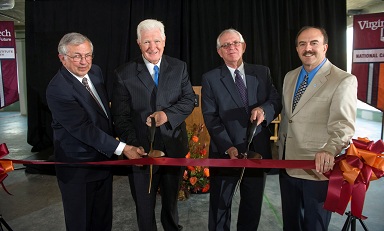
Cutting the ribbon at Virginia Tech Research Center -- Arlington in June 2011 are left to right, Virginia Tech President Charles W. Steger; Congressman Jim Moran; National Capital Region Operations Vice President and Executive Director Jim Bohland, and Arlington County Board Chairman Chris Zimmerman.
- The College of Natural Resources and Environment launches the Executive Master of Natural Resources program in Leadership for Sustainability which emphasizes the need for effective partnerships involving interdisciplinary, multi-institutional, and cross-cultural collaboration among business, civil society, and government.
- The Virginia Tech Research Center—Arlington launches the Leaders in Science and Technology Seminar Series.
- Virginia Tech recognizes the operations staff at the Occoquan Watershed Monitoring Laboratory with Outstanding Performance in Laboratories award.
- Dr. Nathaniel "Nat" White steps down as director of Virginia Tech's Marion duPont Scott Equine Medical Center after nine years of service to the equine community and Dr. David Hodgson, professor and head of the Department of Large Animal Clinical Sciences at the Virginia-Maryland Regional College of Veterinary Medicine, has been named interim executive director of the Equine Medicine Center.
- Occoquan Watershed Monitoring Laboratory celebrates 40th anniversary.

With termination of the lease at 901 Prince Street in Old Town Alexandria, the Virginia Tech Foundation purchases a 1,200-square-foot Greek Revival-style building constructed in 1840 at 601 Prince Street, bringing the total number of university buildings to five within a five-block radius. 601 Prince Street houses offices for six to seven faculty members and design studio space for 75 students enrolled in masters and Ph.D. programs in architecture and landscape architecture offered by the College of Architecture and Urban Studies at the Washington-Alexandria Architecture Center.
- National Capital Region announces NCR Strategic Plan to build on Virginia Tech’s history and strengths in the region. The plan, created by a committee representing all significant operations units within the region, promotes innovative and efficient use of resources to ensure that the region can support all three pillars of the university: learning, discovery, and engagement.
- Virginia Tech offers project management courses in the National Capital Region.
- Philip Spellerberg, retired laboratory specialist, receives 2013 Staff Career Achievement Award from Virginia Tech for his work at Occoquan Watershed Monitoring Lab.
- Michele "Shelley" Duke of Middleburg, Va., is recognized with Virginia Tech’s highest honor – the William H. Ruffner Medal -- for the substantial difference she has made to the university through her volunteer service and support. Her relationship with Virginia Tech spans more than 20 years and started when she began volunteering for and donating to the Marion DuPont Scott Equine Medical Center, located in Leesburg and part of the Virginia-Maryland Regional College of Veterinary Medicine. In 2009, she delivered the address for the university's National Capital Region Commencement.
- Virginia Tech’s Discovery Analytics Center expands its Big Data initiatives to Arlington. Committed to solving knowledge discovery problems in areas of national interest such as intelligence analysis, sustainability and health informatics, the center’s move to the Virginia Tech Research Center -- Arlington capitalizes on proximity to the forces that shape the future of our nation.
- Governor Terry McAuliffe recognizes 50th anniversary of College of Architecture and Urban Studies (CAUS) and notes Virginia Tech's Old Town Alexandria campus and the Washington-Alexandria Architecture Center (WAAC).
- Language and Culture Institute (LCI) opens new site in Fairfax. The new, 12,500-square-foot facility is about four miles from the university’s Northern Virginia Center and about 15 miles from the heart of Washington, D.C..
- Nathan Heavers, assistant professor of Landscape Architecture, recently presented the inaugural Outstanding New Faculty Lecture, sponsored by the National Capital Region Faculty Association.
- Kathleen Hancock receives 2015 XCaliber Award for an individual making extraordinary contributions to technology-enriched active learning.
- Virginia Bioinformatics Institute accepts Outstanding Achievement in Bioscience award from Gov. Terry McAuliffe during a THRiVE 2015 conference in Chantilly, Virginia. THRiVE 2015 was organized by Virginia Bio, a statewide nonprofit trade association representing the life sciences industry in Virginia. Its mission is to connect entrepreneurs with funders, collaborators with partners, and push bioscience in the commonwealth into the 21st century.
- Dr. Michael Erskine is named director of Virginia Tech's Marion duPont Scott Equine Medical Center in Leesburg.
- The Virginia Bioinformatics Institute is given a new direction and a new name — the Biocomplexity Institute of Virginia Tech to reflect the evolution of life science research at Virginia Tech and the university’s ability to continually innovate and refresh its land-grant mission.
- Hume Center, located in Blacksburg and the National Capital Region, launches CyberLeaders 2020 with funding from the William and Flora Hewlett Foundation.
- Virginia Tech and Arlington County join MetroLab Network to accelerate innovations in ‘Smart Cities’: Virginia Tech and Arlington County have formed a partnership to join a MetroLab Network of 35 city/county-university partnerships focused on bringing data, analytics, and innovation to local government.
- Virginia Tech Transportation Institute part of new state legislation enacted for the testing and use of automated-vehicle technologies: While the current law allows a visual display in a motor vehicle, the new bill allows the display of moving images to be viewed while an automated driving system is performing the driving task.
- Virginia Tech offers new master’s degree and certificates in hospitality and tourism: The programs offered in the National Capital Region give graduate students access to industry professionals with proven experience.
- Jaan Holt steps down as director of the Washington-Alexandria Architecture Center
- Susan Piedmont-Palladino named director of Virginia Tech’s Washington-Alexandria Architecture Center
- Thinkabit Lab opens in the National Capital Region: The Thinkabit Lab experience offers both teachers and students an engaging learning environment — part lab, makerspace, and classroom — to foster creativity, collaboration, and the critical skills necessary for the 21st century.
- Virginia Tech Associate Professor Mariana Falconier leads TOGETHER Program: The unique program teaches relationship skills for communication and problem-solving by centering on economic stress; devotes almost half of the time to financial literacy; and focuses on how partners can manage stress together.
- Social and Decision Analytics Laboratory, Arlington County team up: Using administrative data from the county, Virginia Tech researchers are working to increase fire safety and improve 911 emergency response times.
- National Capital Region location strengthens Pamplin’s hospitality and tourism graduate program
- Sudip Bhattacharjee named Thomas M. Wells and Kathy Dargo Professor in Accounting and Information Systems: Sudip Bhattacharjee, professor of accounting and information systems in the Pamplin College of Business at Virginia Tech, has been named the Thomas M. Wells and Kathy Dargo Professor in Accounting and Information Systems by the Virginia Tech Board of Visitors. The Thomas M. Wells and Kathy Dargo Professorship in Accounting and Information Systems was established in 2017 to support teaching and research excellence in the Pamplin College of Business.
- Wenjing Lou receives the Alumni Award for Excellence in Research: Lou’s work on information-centric security and privacy in cloud computing and wireless network security has earned her an international reputation for high-quality, high-impact, and highly innovative research. Lou’s work on information-centric security and privacy in cloud computing and wireless network security has earned her an international reputation for high-quality, high-impact, and highly innovative research. She has more than 180 journal and conference publications. She is among the top-cited scholars at Virginia Tech with 22,700 citations.
- HISTORIC DAY: Virginia Tech Innovation Campus key to Virginia attracting Amazon HQ2: The commonwealth stepped up with a standout higher-education package, including a new Virginia Tech Innovation Campus in Alexandria, which will be located less than two miles from Amazon’s new location in Arlington.
- Tom Woteki to direct Northern Virginia data analysis and applied statistics master’s program.
- Virginia Tech celebrates 50 years of graduate education in the National Capital Region: In 1969, Virginia Tech opened its first Northern Virginia Graduate Center: a white Reston farmhouse with two resident faculty members, a part-time staff, and 65 students.
- Virginia Tech Transportation Institute awarded grants for automated vehicle research: This $15 million in funding enables the institute to drive forward its commitment to developing safety-first, data-based solutions to the nation’s transportation challenges.
- Joseph Simpson appointed director of Integrated Security Education and Research Center
- Children’s National Hospital, Virginia Tech announce partnership for new Children’s National Research & Innovation Campus: The campus is an expansion of Children’s National that is located on a nearly 12-acre portion of the former Walter Reed Army Medical Center in Washington, D.C., and is set to open its first phase in December 2020.
- Lance Collins named Innovation Campus vice president and executive director: Collins, who has led Cornell’s college of engineering since 2010, was a key member of the leadership team that successfully bid to partner with New York City to build Cornell Tech, which opened its Roosevelt Island campus in 2017.
- Alexandria City Council vote clears way for Innovation Campus construction to begin: Alexandria City Council voted 7-0 in support of a development special use permit that clears the way for construction of the 11-story, 300,000 square-foot structure to start next summer in North Potomac Yard.


